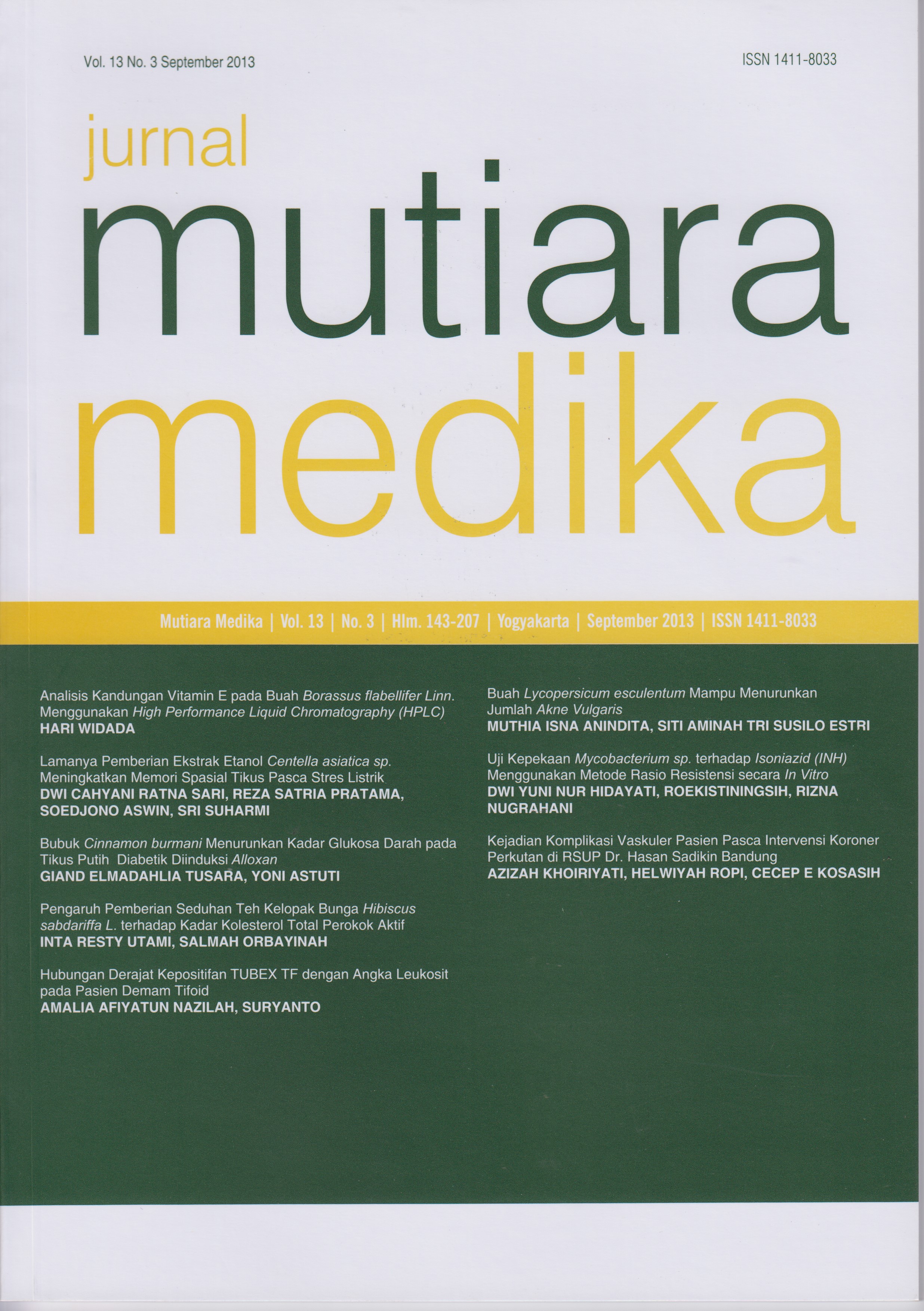Analisis Kandungan Vitamin E pada Buah Borassus flabellifer Linn. Menggunakan High Performance Liquid Chromatography (HPLC)
DOI:
https://doi.org/10.18196/mmjkk.v13i3.2478Keywords:
Vitamin E, Siwalan, HPLC, Validation, Borassus flabellifer Linn, ValidasiAbstract
Vitamin E hanya disintesis di dalam tanaman dan sumber terbanyak adalah tanaman yang menghasilkan minyak, termasuk buah siwalan (Borassus flabellifer Linn.). Siwalan merupakan salah satu tanaman jenis palma yang dapat tumbuh baik di ekosistem pantai dan telah diketahui mempunyai banyak manfaat. Penelitian ini bertujuan untuk menetapkan kandungan vitamin E dalam buah siwalan. Ekstraksi vitamin E dalam buah siwalan dilakukan dengan ekstraksi kering dan ekstraksi basah untuk membandingkan perolehan kadar vitamin E-nya. Ekstrak dianalisis dengan sistem HPLC fase normal dengan sistem kolom: C18, fase gerak: etil asetat/ asam asetat/ heksana = 1/1/198, kecepatan alir 2 mL/ menit, detektor UV-Vis 295 nm dengan volume injeksi 20,25L. Validasi metode analisis untuk menentukan parameter uji kesesuaian sistem, linearitas, limit of quantification, akurasi, presisi dan recovery. Hasil ekstraksi buah siwalan diperoleh rendemen ekstrak basah sebesar 0.152% dan rendemen ekstrak kering sebesar 5.77%. Parameter validasi metode analisis berturut-turut meliputi uji kesesuaian sistem 1.34%, linearitas r2 0.995, limit of quantification 2.14 ng/ mL, akurasi % difference 6.33%, presisi intra-day 4.39%, inter-day 3.88% dan recovery 3.49%. Hasil proses validasi memenuhi kriteria menurut FDA (2001). Hasil analisis kandungan vitamin E diperoleh kadar rata-rata ekstrak kering sebesar 3.19% ± 0.12% dan ekstrak basah sebesar 4.76% ± 0.17%.
Vitamin E is only synthesized in plants and is the largest source of oil-producing crops, including fruit palm (Borassus flabellifer Linn.). Siwalan is one type of palm plants that grow well in coastal ecosystems and have been known to have many benefits. This study aims to establish the amount of vitamin E in the palm fruit. The extraction of vitamin E in the palm fruit is done by extraction of dry and wet extraction to compare the acquisition of vitamin E was. Extracts were analyzed by normal-phase HPLC system with a system of columns: C18, mobile phase: ethyl acetate / acetic acid / hexane = 1/1/198, flow rate of 2 mL / min, UV-Vis detector at 295 nm injection volume of 20 uL. Validation of analytical methods to determine the parameters of the system suitability test, linearity, limit of quantification, accuracy, precision and recovery. Results obtained by extraction of palm fruit extract yield amounted to 0152% wet and dry extract yield of 5.77%. Parameter validation of analytical methods respectively include system suitability test 1:34%, 0995 r2 linearity, limit of quantification 2:14 ng / mL, 6:33 Difference%% accuracy, precision intra-day 4:39%, 3.88% inter-day and 3:49% recovery. Results of the validation process meets the criteria according to the FDA (2001). Results of the analysis of the content of vitamin E obtained an average level of dry extract of 3:19% ± a 0.12% and amounted to 4.76% wet extract ± 0:17%.
References
Hillan, J., Facts about Vitamin E. Department of Family, Youth and Community Sciences, Florida Cooperative Extension Service, Insti-tute of Food and Agricultural Sciences, Uni-versity of Florida. 2006.
Christie, W.W., Tocopherols and Tocotrienols - Structure, Composition, Biology and Analy¬sis, 2011, @ http://lipidlibrary.aocs.org
Xu, Z. Analysis of Tocopherols and Tocotrienols, Protocols in Food Analytical Chemistry. 2002, D1.5.1-D1.5.12, John Wiley and Sons Inc.
Hantoro W.S. Low Stand Sea Level and Land- form Changes: Climatic Changes Conse-quence to Epicontinental Shelf and Fauna Mi-gration Through Indonesian Archipelago. In Preceeding of: “The environmental and Cul-tural History and Dynamics of the Australian- Southeast Asian Region" seminar, Melbourne, 2001 December 10-12.
Mahmud, Z. dan Amrizal. Palma sebagai Bahan Pangan, Pakan dan Konservasi. Buletin Balitka, 1991; (14): 106 - 113. Balai Penelitian Kelapa. Manado.
Nurtama, B. dan I. Naomi.. Paket Industri Pem-buatan Buah Lontar (Borassus flabellifer Linn.) Olahan. Buletin Teknik dan Industri Pangan, 1996; VII (2): 95-99
Amalo, P. Multiguna, dari Akar hingga Nira. Media Indonesia. 21 November 2008. Hal 5.
Sarikaya, B.B. and Kalayar, H. Quantitative De¬termination of D-tocopherol and Quality Con¬trol Studies in Sarcopoterium spinosum L. Mar¬mara Pharmaceutical Journal, 2011; 15: 7-10.
Anonim, Guidance for Industry; Bioanalitical Method Validation, U.S. Department of Health and Human Services Food and Drug Adminis¬tration Center for Drug Evaluation and Re¬search (CDER), Center for Veterinary Medi-cine (CVM), May 2001, p. 4-10.
Irawan,S. dan Widada, H., Validasi Metode Analisis Kandungan Vitamin E pada Buah Kolang Kaling (Arenga pinnata Merr.) dengan Metode High Performance Liquid Chromato-graphy, Skripsi, FKIK, UMY,hal.12, 2014
Adam, S.K., Nik Aziz Sulaiman, N.A., Top, A.G.M. and Jaarin, K., Heating Reduces Vita-min E Content in Palm and Soy Oils, Malay-sian J Biochemistry and Molecular Biology, 2007; 15 (2): 76-79
Gorna[, P., Siger, A., Czubinski, J., Dwiecki, K., SegliFa, D., and Nogala-Kalucka, M. An Al¬ternative RP-HPLC Method for the Separation and Determination of Tocopherol and Toco- trienol Homologues as Butter Authenticity Markers: A comparative study between two European countries. European J Lipid Science and Technology, 2014; 116 (7): 895-903.
Downloads
Issue
Section
License
Copyright
Authors retain copyright and grant Mutiara Medika: Jurnal Kedokteran dan Kesehatan (MMJKK) the right of first publication with the work simultaneously licensed under an Attribution 4.0 International (CC BY 4.0) that allows others to remix, adapt and build upon the work with an acknowledgment of the work's authorship and of the initial publication in Mutiara Medika: Jurnal Kedokteran dan Kesehatan (MMJKK).
Authors are permitted to copy and redistribute the journal's published version of the work (e.g., post it to an institutional repository or publish it in a book), with an acknowledgment of its initial publication in Mutiara Medika: Jurnal Kedokteran dan Kesehatan (MMJKK).
License
Articles published in the Mutiara Medika: Jurnal Kedokteran dan Kesehatan (MMJKK) are licensed under an Attribution 4.0 International (CC BY 4.0) license. You are free to:
- Share — copy and redistribute the material in any medium or format.
- Adapt — remix, transform, and build upon the material for any purpose, even commercially.
This license is acceptable for Free Cultural Works. The licensor cannot revoke these freedoms as long as you follow the license terms. Under the following terms:
Attribution — You must give appropriate credit, provide a link to the license, and indicate if changes were made. You may do so in any reasonable manner, but not in any way that suggests the licensor endorses you or your use.
- No additional restrictions — You may not apply legal terms or technological measures that legally restrict others from doing anything the license permits.






